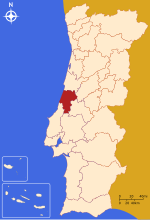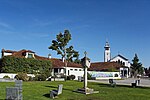Marinha Grande
Cities in PortugalMarinha GrandeMunicipalities of Leiria DistrictPages including recorded pronunciationsPages with Portuguese IPA ... and 1 more
Populated places in Leiria District

Marinha Grande (Portuguese pronunciation: [mɐˈɾiɲɐ ˈɣɾɐ̃dɨ] ) is a municipality in the Leiria District, Portugal. The population in 2021 was 39,032, in an area of 187.25 km². The city itself has a population of 32,330. It is located right in the middle of the 700-year-old Leiria pine forest covering 100 square kilometres, and near excellent beaches such as Praia da Vieira, Nazaré, and São Pedro de Moel. The present Mayor is Aurélio Ferreira, elected by the independent movement +MPM, a coalition formed by MPM and +Concelho. The municipal holiday is Ascension Day.
Excerpt from the Wikipedia article Marinha Grande (License: CC BY-SA 3.0, Authors, Images).Marinha Grande
Rua 18 de Janeiro de 1934, Marinha Grande
Geographical coordinates (GPS) Address Nearby Places Show on map
Geographical coordinates (GPS)
| Latitude | Longitude |
|---|---|
| N 39.75 ° | E -8.9333333333333 ° |
Address
Rua 18 de Janeiro de 1934
Rua 18 de Janeiro de 1934
2430-250 Marinha Grande
Portugal
Open on Google Maps









